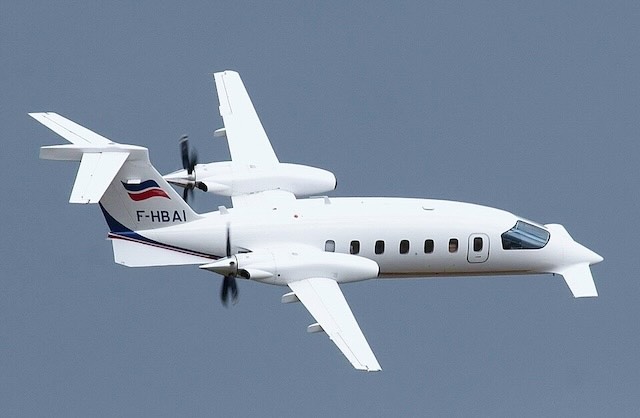P180 Avanti
Summary
| Category | Military Training Aircraft |
| Origin country | 🇮🇹 Italy |
| Manufacturer | Piaggio |
| First flight | 26 September 1986 |
| Year introduced | 1990 |
| Number produced | 246 units |
Description
The Piaggio P.180 Avanti originated during a period of new-generation aircraft development in the 1980s. Engineering studies commenced in 1979, with designs undergoing wind tunnel testing in Italy and the United States throughout 1980 and 1981. In 1982, Piaggio's chief engineer, Alessandro Mazzoni, secured a patent for the Avanti design. A partnership with Gates Learjet from 1983 aimed to develop a fuselage for the aircraft, referred to as Gates Piaggio GP-180. Gates Learjet's financial difficulties led to the cessation of this collaboration in January 1986. Piaggio continued the project independently, and the first prototype achieved its initial flight on 23 September 1986. The P.180 Avanti received Italian certification on 7 March 1990, followed by American certification on 2 October 1990. Initial fuselages were manufactured in Wichita, Kansas, before being transported to Italy for final assembly. Project progression was interrupted after Avanti Aviation Wichita faced financial difficulties in 1994, resuming in 1998 with the involvement of Piero Ferrari.
The Avanti airframe incorporates a three-surface configuration, featuring a T-tail and two small, fixed forewings exhibiting slight anhedral, equipped with landing flaps. On the Avanti II variant, these forewing flaps automatically deploy synchronously with the main wing flaps, which functions to decrease the load on the tailplane by mitigating pitch-down moment. The forward wing is designed to stall at a lower angle of attack than the main wing, inducing an inherent nose-down pitching moment that precedes a main-wing stall. The anhedral angle of the forewing serves to maintain clear airflow paths for engine inlets, the main wing, and the tailplane, minimizing interference. The fuselage possesses a continuously changing cross-section designed to approximate an NACA airfoil profile along its length to prolong laminar flow, a characteristic Piaggio states contributes up to 20% of the aircraft's total lift. Custom airfoil sections developed by Jerry Gregorek are intended to achieve up to 50% laminar flow at cruise speeds for drag reduction, reportedly enabling the main wing area to be 34% smaller compared to conventionally designed aircraft.
The Piaggio P.180 Avanti functions primarily as a civil transport aircraft and does not integrate onboard weapon systems. However, the P.1HH Hammerhead, an unmanned aerial vehicle derived from the Avanti II airframe and operating at medium altitude with long endurance capabilities, can carry a payload of up to 500 kg (1,100 pounds).
The Piaggio P.180 Avanti has been employed across various operational roles, including executive transport, governmental aviation, charter services, and small feeder airline operations. Avantair previously operated a significant fleet consisting of 57 Avanti aircraft. In government service, the Italian Air Force has operated 17 Piaggio P.180 Avantis since 1994, alongside usage by the Italian Army, Navy, Carabinieri, and other state entities. The type has also served with the Royal Canadian Mounted Police (until 2014), Polish Medical Air Rescue, and the air forces of Bulgaria and the United Arab Emirates. In 2003, a Piaggio Avanti piloted by Joe Ritchie and Steve Fossett established transcontinental speed records between San Diego and Charleston, achieving an average speed of 475.2 knots and surpassing a prior turboprop record set in 1986. Observations regarding external noise characteristics have been made at certain airports, with reports classifying it among the noisier aircraft with a high-pitched sound profile.
Main Variants:
-
P.180 Avanti: The initial production version of the aircraft.
-
P.180 M: A military variant configured for combined passenger and freight transport, intended for VIP and light utility applications.
-
P.180 Avanti II: This variant incorporates enhanced avionics and propulsion systems compared to the original P.180 Avanti.
-
EVO: An updated version offering an increased True Airspeed (TAS) of 400 kt and a higher useful load capacity.
-
Multirole Patrol Aircraft (MPA): A derivative of the Avanti II featuring an increased wingspan, enlarged fuel tanks, and enhanced electronic systems for maritime patrol missions.
Technical specifications
| Version: P.180 Avanti II | |
|---|---|
| Maximum speed | 732 km/h (455 mph) |
| Wing area | 16 m² (172.2 sqft) |
| Wingspan | 14.0 m (46.0 ft) |
| Height | 4.0 m (13.1 ft) |
| Length | 14.4 m (47.3 ft) |
| Service ceiling | 12,500 m (41,011 ft) |
| Empty weight | 3,402 kg (7,500 lbs) |
| Max. takeoff weight | 5,489 kg (12,101 lbs) |
| Climb rate | 14.1 m/s (46.3 ft/s) |
| Takeoff distance | 869 m (2,851 ft) |
| Powerplant | 2 x turboprops Pratt & Whitney Canada PT6A-66B delivering 634 kW each |
Current operating countries
| Country | Units | ||
|---|---|---|---|

|
Italy | 18 (+11) | |

|
United Arab Emirates | 2 | |

|
Thailand | 1 | |
All operators

